-
solutinos
-
Hire
Frontend Developer
Backend Developer
-
NodeJS Developer
-
Java Developer
-
Django Developer
-
Spring Boot Developer
-
Python Developer
-
Golang Developer
-
Ruby on Rails Developer
-
Laravel Developer
-
.NET Developer
Technology
-
Flutter Developer
-
React Native Developer
-
Xamarin Developer
-
Kotlin Developer
-
Cross-Platform Developer
-
Swift Developer
-
MongoDB Developer
-
C Developer
-
Smart Contract Developers
Cloud
-
-
Services
Mobile Development
Web Development
- Work
-
Multi Services App
-
Food Delivery App
-
Grocery Delivery App
-
Taxi Cab Booking App
-
Multi Services App
-
OTT Platform APP
-
Social Media APP
-
Freelance Service App
-
Car Rental App
-
Medicine Delivery App
-
Liquor Delivery App
-
Sports Betting App
-
Online Coupon App
-
eLearning App
-
Logistics & Transportation App
-
Courier Delivery App
-
On-Demand Real Estate App
-
E-Wallet APP
-
Online Dating App
-
Handyman Services App
-
-
Process
-
Company
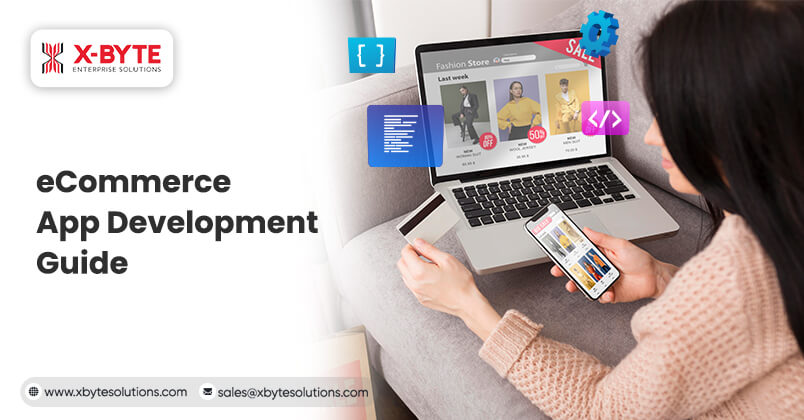
Quick Summary : This detailed ecommerce app development guide provides a step-by-step process to build high-performing solutions for various retail businesses. We have also outlined the cost, factors affecting the cost, development technologies, must-have features, and potential challenges. This guide will help diverse businesses to create a strong digital presence in the expanding ecommerce industry.
The modern eCommerce market has experienced a rocketing wave since its establishment and has not experienced any downfall since then. The industry's future will expand in the coming year with growing technological advancements and the increasing use of smartphones and internet users. This raises the need for entrepreneurs to promote eCommerce segments using digital platforms, social media, smooth payment integrations, and omnichannel models.
With its inscription before 40 years by Michael Aldrich ( English entrepreneur), electronic commerce was not considered handy, but later, it became popular and an inseparable aspect of our routine lives.
Statistics and Important Highlights
- Recent research concluded that mobile eCommerce sales are forecasted to cross $7.05 trillion by 2027. This highlights the scope of growth in the eCommerce industry and opens the door to entering the market and expanding by attracting more customers.
- Investing in top-notch mobile apps for eCommerce assists businesses in boosting customer conversion rates, engagement, and revenue generation opportunities by expanding market reach.
- In 2023, the revenue of the eCommerce app reached $3.88 trillion, which is an 8.1% boost from last year.
- In the US, mobile eCommerce is calculated as a total retail of 7.6% in the year 2023. On the other hand, in the UK, it was 16.8%
- The eCommerce segment is rapidly expanding through social media channels like Facebook, TikTok, and Instagram.
- There is an 85% cart abandonment rate of mobile responsive eCommerce sites.
- The Ecommerce industry is segmented by types, geography, and platform.
What is eCommerce App Development?
The eCommerce mobile app development is also called m-commerce or mobile eCommerce. The eCommerce app development is the streamlined process of creating designs and developing a feature-packed app to ensure the smooth buying and selling of products and services using digital platforms. Additionally, it acts as an online marketplace that can be easily accessible through mobile phones, which is considered a vital component of the retail network in this ever-evolving network. The eCommerce mobile applications provide a custom platform to transform retail businesses, startups, and emerging retail enterprises. This enables users to search, evaluate, get personalized recommendations, and purchase the required products conveniently.
ecommerce mobile apps are highly optimized to build strong buyer-seller relationships.
Transactions in the ecommerce segment are classified as business-to-business (B2B), business-to-consumer (B2C), and consumer-to-consumer (C2C).
eCommerce App Development Trends
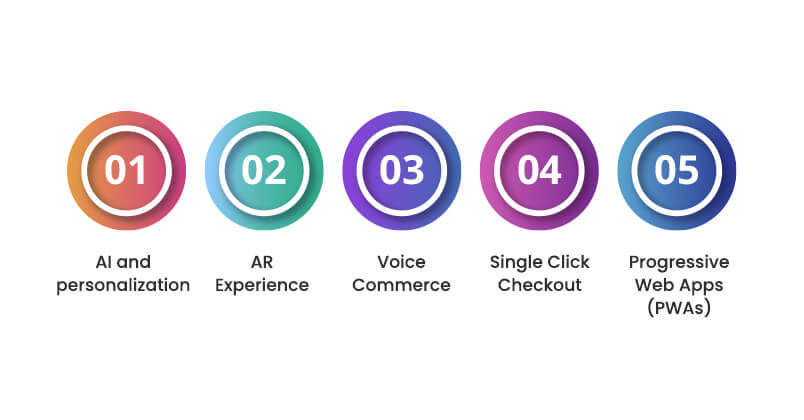
eCommerce mobile applications have transformed customer buying behavior. Traditional shopping methods, where buyers need to visit the store physically, are replaced with online shopping platforms. These platforms allow customers to buy required products conveniently with a few fingertips.
Let's analyze the eCommerce app development trends to revolutionize the user experience.
AI and personalization
AI algorithms seamlessly analyze user browsing patterns and past buying history to display personalized recommendations. This assists in boosting customer engagement and conversion rates, expanding revenue opportunities. Advanced technology is also utilized to create AI-enabled chatbots by training them based on retail business needs.
They implement this into their platform to provide real-time assistance and support to customers, solving their queries and providing guidance on how to use the platform from browsing to checkout. The core aim is to boost customer satisfaction and sales.
AR Experience
Establishing a real-life experience of in-store shopping on digital shopping platforms can be easily achieved by implementing AR/VR. Ikea is the most successful retail business, and it has proved to be a successful brand that provides the best AR experience.
Customers can easily find the catalog of all the products in AR mode. This is highly preferable in fashion, furniture, and home decorative items. It is because this modern tech uses' virtual try-ons' and visualizes the products in their setup.
Voice Commerce
The rise of voice-enabled devices like Siri, Google Assistant, and Alexa has provided a convenient way to shop through voice commands. eCommerce apps are highly optimized for natural language processing and searches, making it easy for customers to browse products with a voice search facility.
Single Click Checkout
A multi-click checkout process can lead to a high cart abandonment rate, as it frustrates customers, who shift to other platforms with shorter checkout processes. One-click checkout drives time-conscious customers to complete the purchase process with saved details like address, payment, and other specifications in a few seconds. This assists in elevating conversion rates and reducing friction during checkout. Several ecommerce platforms prioritize seamless checkout to boost customer satisfaction and engagement.
Progressive Web Apps (PWAs)
PWAs provide an app-like experience on the browser without installing an application to get a smooth shopping experience. Compared to other solutions, PWAs load quickly and provide diverse features like real-time alerts, offline access, and personalized recommendations without the requirement of strong network connections. These apps offer convenient alternatives to users who are reluctant to install applications.

Get custom eCommerce mobile apps to stay competitive in the evolving market!
Connect with Experts Connect with ExpertseCommerce App Development Process
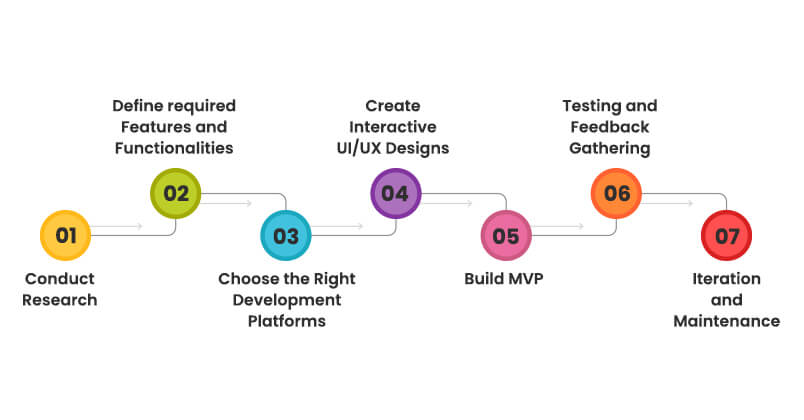
eCommerce app development can be done by following pre determined steps to build high performing and optimized solutions that can be seamlessly accessed on various platforms.
Our expert eCommerce app developers recommended the below steps to build market-leading retail business apps like Amazon, Flipkart, Shopify, and others.
- Conduct Research
- Define Required Features and Functionalities
- Choose the Right Development Platforms
- Create Interactive UI/UX Designs
- Build MVP
- Testing and Deployment
- Support and Maintenance
Conduct Research
Comprehensive research=more streamlined solutions!
Conduct in-depth research on market trends, competitors, and user preferences to determine the target audience and market segment. It helps determine the market segment and target customers.
Define required Features and Functionalities
Once you analyze the market trends, technological advancements, and competitor actions, it's a good time to outline the required features and functionalities. This helps you get feature-packed apps that boost user engagement.
Choose the Right Development Platforms
Our experts suggest analyzing complexities and processes before selecting the ideal technology for eCommerce app development. On the other hand, it is crucial to examine the app development cost when choosing a specific development technology, database, framework, or platform.
This estimation assists in finalizing the type of application:
- Native application development
- Hybrid app development
- Cross-platform application development
- iOS app development
- Android app development
Create Interactive UI/UX Designs
Engaging UI/UX is the ideal alternative to stand out from the competition and provide a smooth shopping experience. Our certified UI/UX developers use advanced tools to create engaging and responsive designs tailored to unique business needs.
Build MVP
Focusing on MVP development is crucial to creating a market-leading eCommerce app. MVPs' main goals are analyzing user feedback, allocating expert resources based on requirements, minimizing unnecessary risks, and reducing development time.
Testing and Feedback Gathering
After releasing the MVP, user feedback is collected. This is done to analyze user engagement, required improvements, and responsiveness, which assists in providing user-centric apps to target audiences.
Iteration and Maintenance
Following well-known businesses from the eCommerce industry indicates they are constantly updated with market advancements. They update their systems with changing market scenarios to meet user requirements.
Must-have Features in eCommerce Mobile Apps
Ecommerce app development can be highly optimized and ensure a streamlined workflow by implementing features that fulfill the requirements of the users within the retail platform. These solutions are customized based on the business requirements and project specifications. A few of the necessary features are listed below:
User-Friendly Interface (UI) and Navigation
An eye-catching and engaging user interface helps with smooth browsing, searching, and finding products. Responsive designs with clear navigation, categories, filters, and search bars boost the shopping experience and user engagement.
Secure and Multiple Payment Options
To fulfill user preferences, implementing various payment methods, such as credit/debit cards, digital wallets (PayPal, Apple Pay, Google Pay), and even Buy Now, Pay Later (BNPL) options, necessitates adopting high-tech security and encrypted transactions.
Easy Registration and Login Options
A quick and simple sign-up process is essential, with options to sign up or log in via social media accounts, email, or phone numbers. Implementing biometric login options, like fingerprint or facial recognition, provides extra convenience and security.
Smart Search and Filter Options
A robust search bar includes autocomplete, voice search, and filters (price, brand, category) that help users easily find required products. These features improve the browsing experience, especially in large catalogs.
Personalized Recommendations
AI-enabled recommendation features can suggest products based on the user's browsing history and previous purchases. Personalization increases engagement and helps customers discover relevant items.
Shopping Cart and Wishlist
It is essential to have a persistent shopping cart that saves items even after a user exits the app. The wishlist feature lets users save items for later, which can boost conversion rates when paired with notifications on price drops or stock updates.
Push Notifications
Push notifications provide real-time alerts to users about sales, new arrivals, abandoned carts, and stock updates. Custom notifications are the best approach to keep users engaged with services.
Order Tracking
For a smooth ordering process, providing real-time tracking of orders and notifications about shipping status, delivery dates, and potential delays is essential. This helps build transparency and keeps customers and potential customers informed.
Customer Support and Chatbots
A responsive support setup with live chat, FAQs, and email support makes it easier for customers to resolve issues quickly. Smart chatbots can help customers solve queries in real-time at their convenience, ultimately boosting user experience.
Boost the business presence with our expertise in creating highly engaging ecommerce mobile apps.
Key Challenges in eCommerce App Development
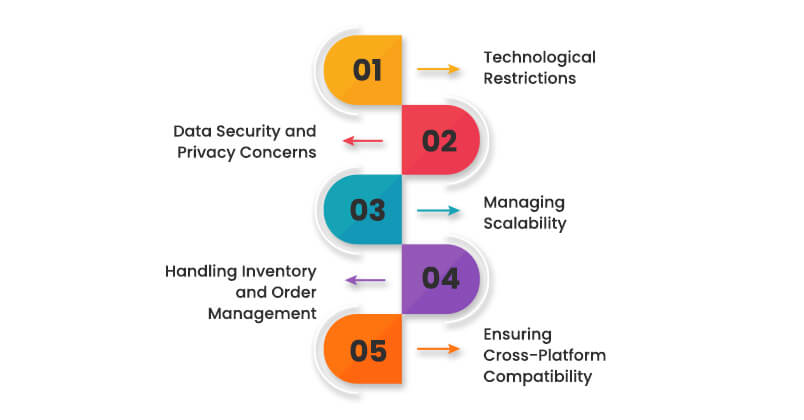
Developing an eCommerce app can be value-adding to business but comes with challenges that require careful planning to overcome. Here are some common challenges.
Technological Restrictions
When eCommerce apps are not integrated with advanced technologies like AI/ML, AR/VR, data visualization, and others that offer eye-catching user experiences, conversion rates may be reduced.
Data Security and Privacy Concerns
The eCommerce app's lack of robust data security and management features makes it insecure and raises privacy concerns. This can be resolved by implementing secure user authentication (OAuth, JWT) and enforcing multi-factor authentication.
Managing Scalability
As your user base grows, your app needs to handle more traffic and data without compromising performance. So, it is essential to use scalable cloud platforms to expand usability.
Handling Inventory and Order Management
Keeping real-time inventory status and processing orders can be complex, especially with high transaction volumes. However, this can be resolved by implementing automated inventory management systems.
Ensuring Cross-Platform Compatibility
eCommerce app development for iOS and Android separately can be time-consuming and requires extra resources. Developers can use cross-platform frameworks like Flutter or React Native, which enable a single codebase for both platforms.
What are the Popular eCommerce App Development Frameworks?
Considerations like budget, project complexity, platform requirements, and time constraints can help you choose the best framework for your needs.
Here are some of the most popular frameworks for developing eCommerce apps, each with its own unique capabilities:
- Flutter
- React Native
- Ionic
- Angular and Vue.js
- Laravel and Node.js
Flutter
Google created Flutter, a UI toolkit for building cross-platform apps with a single web, mobile, and desktop codebase. It offers a rich set of pre-designed widgets, fast development cycles with Hot Reload, and beautiful UI designs.
React Native
React Native is the open-source UI platform created by Meta platforms. It is utilized to create applications for Android, Android TV, iOS, Apple TV, macOS, Windows, web, and UWP by enabling expert developers to utilize the React framework with native capabilities. It can be easily integrated with third-party plugins and offers a strong community and extensive library support.
Ionic
Ionic is an open-source framework that allows developers to build cross-platform mobile apps using web technologies (HTML, CSS, JavaScript). It is highly flexible, can be easily integrated with extensive plugins, and can be paired with fast prototyping.
Angular and Vue.js
Angular and Vue.js are popular JavaScript frameworks used to build Progressive Web Apps (PWAs), which can also be integrated with eCommerce backends. They are lightweight, fast, and cost-effective, making them highly suitable for PWAs with offline capabilities.
Laravel and Node.js
Laravel (PHP) and Node.js (JavaScript runtime) are backend frameworks for creating powerful and secure APIs and robust server-side functionalities for eCommerce. It ensures strong performance, extensive community support, and easy integration with front-end frameworks like React or Vue.
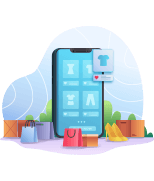
Leverage the expertise of our dedicated eCommerce app development team to get custom eCommerce apps.
Contact Our Team Contact Our TeamFactors Influencing the Cost of ecommerce App Development
Developing an eCommerce app has a range of cost drivers, from the choice of features and platform to the team's location and expertise. By understanding these factors, you can plan a budget that aligns with your project's scope and desired quality level. Diverse factors influence the cost of eCommerce app development, each adding unique challenges and value to the app's functionalities. Below are the common influencing factors:
- App Complexity and Feature Set
- Platform Choice (iOS, Android, or Both)
- App Design and User Experience (UX/UI)
- Backend Infrastructure and Database Management
- Expertise of the Development Team
- Security and Compliance
App Complexity and Feature Set
The essential features and functionalities, like user registration, product catalog, search, and checkout, streamline the eCommerce app. Implementing these basic features makes the apps simpler and reduces costs. So, basic features, customization, and advanced features can greatly affect cost.
Platform Choice (iOS, Android, or Both)
The cost of eCommerce app development can be highly influenced by platform and type of app, such as single-platform (iOS or Android) and cross-platform app development. The development tools and technologies selected to create these solutions can also impact the cost of eCommerce app development.
App Design and User Experience (UX/UI)
Simple layouts and standard themes are more cost-effective, but apps with custom icons, animations, and unique interfaces attract users but incur development costs.
Backend Infrastructure and Database Management
eCommerce apps manage extensive data within a single platform, from products to customer details. Building a robust and scalable backend infrastructure requires a higher initial cost.
Integration with Third Party Services
Integration with services like payment gateways, CRM systems, or inventory management tools provides convenient solutions for users. However, this can raise the cost when complex data sync is required.
Expertise of the Development Team
Highly experienced and expert eCommerce app development agencies and teams deliver high-quality and market-leading solutions, but they can cost you a lot. However, these agencies ensure constant support and maintenance services to stay updated with the advancements in the market.
Security and Compliance
Custom eCommerce apps manage the sensitive and crucial data of businesses and users. So, it is advisable to invest in robust security measures like encryption, secure login, and regular security audits, which add to the cost. Our team also assists startups and businesses in meeting legal and industry standards, such as GDPR or PCI-DSS, for payment processing, which adds time and cost. However, it is crucial to gain user trust by following industry standards.
Final Words!
It’s the right time to enter the digital retail business and expand globally. To sustain themselves in the evolving ecommerce market, businesses are adopting modern technologies and digital platforms to establish a strong online presence. This is booming because of the increasing use of smartphones, which are relied on for online shopping and reach to global segments. eCommerce apps open the door to international opportunities for emerging startups, businesses, and well-established enterprises by offering user-centric solutions.
You can develop a futuristic eCommerce app with the industry-leading team of X-Byte Solutions. As an industry leader for over a decade, we help with full-cycle app development services to transform traditional businesses into global leaders. Contact our expert team to share your requirements and get transformative solutions to your unique needs.
Frequently Asked Questions
-
What are the major business models of
eCommerce app development?
- Business-to-Business (B2B)
- Business to Government (B2G)
- Business-to-Consumer (B2C)
- Consumer-to-Consumer (C2C)
- Consumer-to-Business (C2B)
- On-Demand Services
- Marketplace Model
- Subscription-Based Model
- White Label and Private Label
-
How to Develop a Successful eCommerce
App?
To develop a feature-rich and successful eCommerce mobile app, it is important to consider:
- User-friendly interface
- High tech security
- Implementing advanced features
- Easy navigation
- Incorporating multiple payment options
- Implementing analytics tools
-
What are the technologies used for responsive eCommerce apps?
- Frontend Technologies: Swift and Objective-C are used for iOS apps, and Kotlin and Java are used for Android apps. Cross-platform frameworks like React Native and Flutter allow development for both platforms.
- Backend Technologies: Node.js, Django (Python), and Ruby on Rails are commonly used backends for handling data, user accounts, and business logic.
- Databases: MySQL, PostgreSQL, and MongoDB are popular options for storing product data, customer information, and transaction records.
- Cloud Services: Amazon Web Services (AWS), Google Cloud, and Microsoft Azure for scalable and secure hosting.
- Payment Gateway Integration: Stripe, PayPal, Square, or Braintree to facilitate secure payment processing.
-
What are the popular eCommerce app development frameworks?
- React Native: Enables the development of applications for different platforms with a single code.
- Flutter: Provides a nearly native performance level and intensive UI functionalities, enabling multiplatform usage.
- Xamarin: An open-source framework sponsored by Microsoft, compatible with C# and for it’s rich collection of libraries, making it ideal for cross-platform applications.
- Magento: This has a solid backing, making it suitable for large eCommerce initiatives involving the selling of many products.
- Shopify Mobile SDK: Perfect for firms interested in building a mobile app compatible with Shopify and its surroundings.
-
What are the common mistakes to avoid in ecommerce app
development?
- Ignoring user experience
- Overloading with features
- Not prioritizing security
- Skipping testing
- Not planning scalability
-
How can I promote my eCommerce app effectively?
- Social media marketing
- Partnerships with influencers
- App store optimization
- Offers and discounts
- Email marketing
- Push notifications
- Continuous feedback
